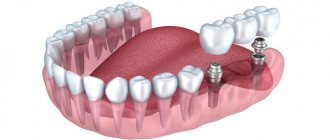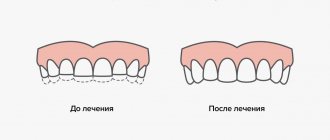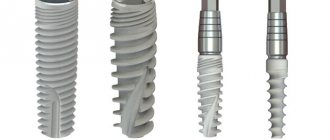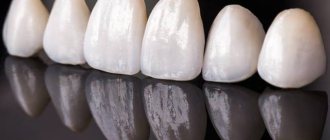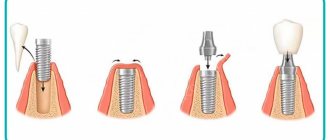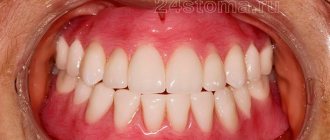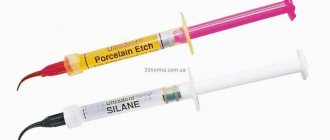01/22/2019 Modern dentistry offers various methods for correcting chips, cracks and other dental defects. One of the popular solutions is extension, which allows you to return the tooth to its original color and shape. What the procedure is and who it is suitable for - you will learn about this from our article.
- What is tooth augmentation?
- Indications and contraindications for the procedure
- Advantages and disadvantages of dental extensions
- Basic methods of filling
- Installation of veneers
- Installation of crowns
- Extension on a pin
What is tooth augmentation?
Dental augmentation is a dental procedure that allows you to restore the appearance of teeth and restore their lost functionality. A type of extension is artistic restoration - a technique for restoring the front teeth.
Both procedures are performed using special materials that are visually similar to the texture of natural enamel. The restored unit has the same shade and texture as natural dental tissue, is highly durable and lasts for at least 10 years.
Veneers or composite dental restoration: comparison
It is better to compare ceramic veneers and restoration with composite materials in a comprehensive manner. This will help to cover all the nuances of the methods and show significant differences. Main criteria for comparison:
- Wear resistance. Ceramics have increased strength and good abrasion resistance. If you follow your dentist's recommendations, ceramic and zirconium veneers last a very long time. Filling composite restorations are less durable and require systematic correction and polishing.
- Features of color rendering. Zirconium dioxide and ceramic compositions are selected in such a way that they completely imitate the color and natural transparency of enamel. The pads are resistant to food coloring and retain their original color throughout the entire period of wear. Composite materials have some porosity and, in the absence of timely polishing, can become susceptible to the color of drinks and dishes consumed - begin to stain from coffee and tea.
- Tooth treatment. Classic indirect veneers require the removal of a layer of enamel for an ideal restoration of the frontal area. Composites generally do not require such preparation, although it is sometimes necessary.
- Fastening strength. The quality of gluing depends on many factors. When veneering, the doctor must avoid any voids under the onlays and firmly fix the plates on the surface. The adhesion of composite filling compounds is stronger, and peeling when worn is also eliminated.
- Manufacturing. Composite restoration is a long and painstaking work of a doctor. It is necessary to evaluate the contacts of the restored unit with neighboring teeth, determine the points of closure during chewing and smiling. This often requires resurfacing or additional build-up - precise visual assessment and professional craftsmanship. Ceramic veneers are made in the laboratory using impressions, which guarantees anatomical accuracy of the onlays.
- Duration of treatment. The doctor performs the restoration during one appointment. Installing veneers requires more time - first, impressions are taken from the teeth and a temporary version of the onlays is installed, then the plates made in the laboratory are fixed for permanent wear.
- Possibility of repair. If the veneer is damaged, it must be replaced with a new one. Composite restorations are easier and often faster to restore.
- Price. The cost of aesthetic reconstruction of one tooth is significantly lower than the production of a ceramic plate for one incisor.
Veneers or composite restoration? Despite the fact that the patient has full access to information about the materials, indications and advantages of both methods, he should not make an independent decision about the treatment option. It is more correct to listen to the doctor’s opinion, take into account the specialist’s experience and arguments.
Indications and contraindications for the procedure
Extension is indicated in the following cases:
- Chips and cracks on the tooth surface.
- Destruction of enamel or its discoloration, which cannot be eliminated with bleaching.
- Partial tooth loss due to injury or caries.
- Malocclusion.
- Interdental gaps.
- Age-related wear of enamel, in which the dental unit darkens and becomes sensitive to external influences.
However, restoration is not suitable for every patient. It cannot be performed if one of the contraindications is present:
- Untreated caries or gum disease.
- Severe systemic diseases, such as blood diseases or diabetes.
- Some mental disorders.
- Bruxism.
- Bruxism. Individual intolerance to the components of the filling composite.
There are also technological limitations: if it is impossible to protect the restored surface from contact with moisture (for example, saliva), then the extension will have to be abandoned - the filling will not harden. Also, some methods cannot be used for dental treatment in children - for example, they do not have pins installed. For most patients, augmentation remains the optimal solution for restoring a lost tooth fragment.
Advantages and disadvantages of dental extensions
In dentistry, various methods are used to restore lost tooth fragments, but for most patients, doctors recommend paying attention to tooth extensions. This is due to the numerous advantages of the procedure:
- A large selection of technologies and materials allows you to choose the optimal solution for each person and restore both front and back teeth.
- Highly aesthetic results.
- The restoration does not affect neighboring (healthy) units, does not increase the chewing load, that is, it protects the dentition from accelerated wear and destruction.
- Minimal trauma: oral tissues heal quickly without causing significant discomfort to the patient.
- The materials used during extensions are durable, aesthetically pleasing, do not change color and strength during use.
Dental extensions have virtually no disadvantages. The only drawback is the fairly high cost of services, but it can be adjusted by choosing simpler restoration methods and more affordable materials.
Basic methods
There are several methods of teeth extension, differing in technology, compositions used, and price. The main methods include:
- Filling.
- Installation of veneers.
- Installation of crowns.
- Extension on a pin.
Each method has its advantages and disadvantages, which are discussed below.
Sealing
Filling is one of the simplest and most affordable ways to build up a tooth, provided that the bone tissue is preserved. The dentist selects a shade of the composite that is as close as possible to the patient’s natural enamel color. Then the composition is applied layer by layer to the dental unit, resulting in the formation of a monolithic structure with a tooth. The filling hardens under the influence of light - it quickly gains strength and practically does not wear out over time. The top layer is sanded and varnished, due to which it most accurately replicates the natural relief of dental tissue.
The main advantages of filling:
- Nerve preservation.
- Possibility of restoration of both minor defects and severe damage.
- High speed of the procedure - you can restore a tooth in one visit to the dentist.
The disadvantages include the fact that the aesthetics of the restored tooth directly depends on the skill of the dentist, who must give it the most natural shape possible. There is almost always a risk that the filling will look less natural than the “native” hard tissue of the unit.
Installation of veneers
Another way to build up your teeth is to install veneers. They are thin porcelain microprostheses that imitate the front surface of a tooth. Overlays allow you to hide discoloration, signs of enamel destruction, chips and make your smile attractive.
The service life of the plates is 10-15 years, during which they do not change color even with frequent consumption of coloring products (berries, wine, coffee). But dental porcelain can crack under high loads and direct impacts.
Before installing the veneer, the tooth is prepared - the top layer of enamel is removed. Then a plate is applied and fixed with dental cement. This extension technology is used to restore only the front teeth. Among the main advantages of the technique are:
- High aesthetics.
- Long service life of structures.
The disadvantages include the need to remove the top layer of enamel. This can be avoided by installing lumineers - even thinner microprostheses that are fixed directly to the tooth surface without preliminary preparation (grinding).
Installation of crowns
Crowns are metal, ceramic or metal-ceramic caps that imitate the surface of one or more dental units. Installing crowns allows you to compensate for serious defects - for example, chips or the complete absence of several teeth, and restore beauty and functionality to your dentition.
The denture is made in a dental laboratory using a previously taken impression, so it fits the patient perfectly. Before tooth augmentation, the oral cavity is sanitized, nerves are removed, and the units on which the crown will be placed are turned. The procedure requires multiple visits to the dentist.
Modern crowns made of ceramics and metal-ceramics restore aesthetics to the smile. The material imitates the shade of enamel, does not absorb food coloring, and does not wear out during use. The service life of crowns depends on the manufacturing technology and averages 10 years or more. The main advantages of this extension technique:
- Possibility of restoration of both anterior and chewing teeth.
- Restoration of dental units with partial or complete edentia.
- Highly aesthetic results.
Among the disadvantages is the fairly high cost of the procedure. However, the price can be reduced by using more affordable materials in the crown manufacturing process.
Extension on a pin
Extension on a pin or pinning is recommended by the dentist if the hard tissues of the tooth are destroyed, but the root is not damaged. During the procedure, a rod is screwed into the jaw, onto which a temporary crown is placed.
After the surrounding tissue has healed, the temporary crown is replaced with a permanent one. Advantages of this extension method:
- Possibility of restoration of both front and back teeth.
- A wide variety of post materials allows the patient to influence the cost of the restoration towards its reduction.
- Long implant lifespan.
The disadvantages usually include the need to restore tissue after implantation of the rod, during which a person experiences some discomfort (inflammation and swelling of the gums). Another disadvantage is the relatively high price of pin extensions.
Pros and cons of extensions
All modern methods of teeth extension used in dental practice have positive qualities, in particular:
- tooth restoration can be carried out even in the most inaccessible places;
- the restored tooth is practically no different in appearance from the natural one;
- Compared to prosthetics, the extension procedure is much cheaper;
- doctors use only anti-allergenic agents for filling;
- in most cases, one visit to the doctor’s office is enough for the complete restoration of one or several teeth;
- they resort to extensions even when the patient’s tooth is completely destroyed. This makes the procedure indispensable for high-quality and quick recovery;
- maximum preservation of damaged tooth tissue occurs during extension;
- High-strength modern materials used for fillings are in no way inferior in their properties to human bone tissue, so the restored front teeth serve their bearers for many years.
Beautiful teeth
On a note! When building up, there is no need to install prostheses, which greatly simplifies the restoration process.
The peculiarity of the extension is also that in some patients the restored tooth may become damaged 10-12 months after the procedure, while in others it lasts for more than 8 years.
- Restoration of anterior teeth with filling material
The duration of the operational period can be affected by certain factors, including the presence of bad habits, diet, compliance with oral hygiene rules, doctor’s experience, and so on. Even if the patient skips one teeth cleaning a day, all the doctor’s work and money spent on the procedure will be wasted.
Teeth cleaning
Therefore, before you decide to choose a tooth extension method, ask yourself: can you force yourself to lead a healthy lifestyle and observe basic oral hygiene? In any case, this is the patient's decision and nothing more.
Video: Teeth extensions - pros and cons
Choosing a teeth extension technique
You can choose the optimal method of tooth extension only after consulting a dentist. The doctor will assess the degree of destruction of the dental unit, check the safety of the root and nerve, and depending on this, recommend a suitable method of restoration.
For example, veneers or lumineers are most often used to restore minor damage to incisors and canines. They hide visual defects, straighten the dentition, and return lost whiteness to the unit.
If the hard tissues of the tooth are seriously damaged, then you should resort to crowns or extensions to a pin. In this case, you can completely restore the unit and return it to functionality.
When consulting with a dentist, you need to clarify:
- The service life of the restored tooth, its resistance to wear, food coloring, and the possibility of restoration in the event of a chip. For example, some crowns can be repolished if minor defects appear; reinstallation of the microprosthesis is not required.
- The number of procedures for which it will be possible to grow a tooth. The fastest options are filling and installation of lumineers. Other technologies will require multiple visits to the clinic.
- Tissue healing rate. Some augmentation methods allow you to restore a tooth without damaging the gums. This guarantees the patient minimal discomfort after the procedure.
Different types of extensions differ in price, which must be taken into account when choosing a technique.
Reinforcing a broken tooth onto a pin
If the tooth root is healthy, the dentist can model an exact anatomical copy of its crown using computer technology. An x-ray is performed first.
The procedure is carried out as follows:
- A metal pin is installed into the sealed root canal;
- A filling compound is introduced, from which a new crown is formed.
Advantages of the method:
- Possibility to save the tooth root;
- High strength of the restored tooth due to double fasteners - the root and the pin.
Pins are used in cases where it is required:
- Building up the foundation;
- Strengthening a pulpless tooth;
- Reconstruction of a damaged tooth;
- Creating the basis for crown formation;
- Restoration.
The newest development is the use of fiberglass pins.
Cost of procedures
Prices for dental extensions vary depending on:
- Number of units restored.
- Severity of the defect.
- The chosen extension technique.
- Materials used.
The cost is also affected by the condition of the oral cavity, the preservation of the tooth root, the need for preliminary sanitation and other procedures. The final price of services is determined after examination by the dentist. The patient can influence the final cost by choosing more affordable composites and restoration technologies.
Regardless of the chosen technique, the doctors at the Ulybka dental clinic guarantee their patients beautiful and long-lasting results. Our specialists have extensive experience in building extensions of varying complexity, have modern tools and use advanced materials to ensure a highly aesthetic result.
You can find out the cost of extension of front and back teeth in Yoshkar-Ola in our price list.
How to grow your front teeth?
There are several ways to build up your front teeth. In most cases, it will be possible to restore functional and aesthetic characteristics using photocomposites. By applying the material layer by layer to the defect site, the doctor can completely eliminate the defects. The only negative: in order to preserve the aesthetic properties for as long as possible, you will have to adhere to some dietary restrictions at home, as well as regularly seek professional teeth cleaning.
If more than 70% of the crown part of the tooth is missing, then it is ideal to turn to an orthopedic technique. Modern ceramics used to make crowns make it possible to perfectly imitate the texture of a tooth and achieve a match in color and transparency to natural enamel.
Another current way to correct teeth in the smile area is to build teeth using veneers. They can be composite and made by a doctor directly in the patient’s mouth, as well as ceramic. The production of these onlays takes place in a dental laboratory, after which they are glued to the teeth using special cement. The thickness of the linings is small. However, in order not to excessively increase the tooth surface with such a procedure and to ensure strength, grinding of the tooth surface will be required. Videos available in the public domain will allow you to verify the careful approach of specialists to such a procedure.
Advantages and disadvantages of extensions
The benefits of dental extensions include:
- Possibility of ensuring reliable tooth restoration. In some cases, an extended tooth is not much inferior in wear resistance and durability to a natural one.
- Natural result. Thanks to modern materials, it is possible to choose not only the desired shade of the tooth, but also provide the necessary transparency. The extended tooth will not be distinguishable from its neighbors. A natural smile is guaranteed.
- High efficiency of the procedure. The result is achieved even if even a tooth from which practically nothing remains is subject to restoration.
- Possibility of quickly obtaining results. Depending on the chosen method, 1-2 visits to the doctor are enough.
Cons of teeth extensions:
- Quite a high cost;
- The inability to clearly determine how long the service life of a tooth will be;
- Dependence of results on the professional skills of the doctor.
Contraindications
There are few contraindications to dental extensions. Among them:
- Complete destruction of the crown part of the tooth;
- Tooth mobility due to damage to periodontal tissues;
- Bruxism;
- Allergic reactions to the materials used;
- Severe dysfunction of the temporomandibular joint.
The decision on the possibility of using a particular technique in each specific case is made by the dentist.
FAQ
- What kind of doctor does dental extensions? Depending on the technique used, a dentist-therapist or an orthopedist will solve the problems.
- Will it be possible to build up baby teeth? Is such a procedure necessary? At the present stage, using modern filling materials, it is possible to solve the problem with baby teeth. However, treatment is complicated by the fact that it is difficult to ensure a static position for the child during the manipulation. Often you have to resort to anesthesia. The need for such a procedure is justified by the fact that ignoring it will lead not only to deterioration of aesthetics, but also to problems with bite and diction disorders.
Price
The cost of tooth augmentation varies widely depending on the technique used. In this case, the most accessible way is to use therapeutic approaches. The use of orthopedic techniques will be more expensive. Due to the complexity of the technology, the installation of ceramic veneers will be especially expensive. The price of such a procedure also increases due to the fact that the entire smile area is subject to correction. To achieve the desired result, you will need to install about 8-10 units of overlays. At the same time, if you are counting on having your teeth augmented in a center whose core business is to provide the population with high-quality but affordable services, contact the Evita clinic.
| Cosmetic tooth restoration with light-curing materials | 10550 rub. |
| Ceramic inlay (1 unit) | 35400 rub. |
| Ceramic veneer (1 unit) | 56,000 rub. |
| Lumineers veneer (1 unit) | 82700 rub. |
| Veneer Emax (1 unit) | 48,000 rub. |
